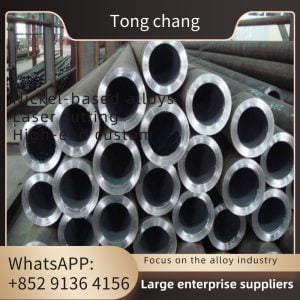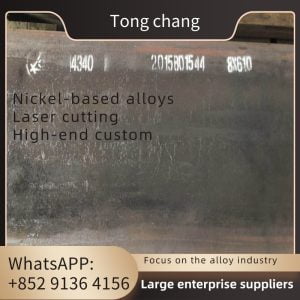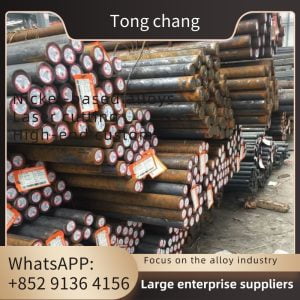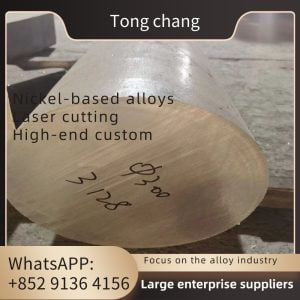| Product Name: | G-type Finned Tube | Tube Standard: | ASTM B163, ASME SB163 |
|---|---|---|---|
| Tube Material: | Monel 400 (UNS N04400) | Type: | G Type Embedded |
| Tube OD: | 20mm To 219mm OD Max. | Tube Thickness: | 2mm To 16mm |
| Tube Length: | Can Customized | Fin Material: | Aluminum, |
| Fin Thickness: | 0.8mm To 4mm | Fin Height: | 0.25′ (6.35mm) To 1.5′(38mm) |
| Fin Density: | Customize, FPI/fins Per Inch | ||
| High Light: | ASME SB163 Monel 400 Nickel Alloy Tube G Type Embedded Finned Tube | ||
G-type Embedded Fin Tube ASME SB163 Monel 400 Nickel Alloy Bare Tube with Aluminum Fin
G-type embedded fin tube is a type of circumferentially finned tube where the fin is mechanically embedded into a groove that is ploughed into the tube and locked into place by rolls that force the groove to tightly close around the fin base. We can supply the G-Fin Tubes in the following combinations of Base Tube and Fin Material:
Base Tube Material: Carbon Steel, Alloy Steel, Mild Steel, Stainless steel and tubes manufactured by ERW or Seamless Process
Fin Material: Aluminum, Copper
What is G-Fin Tube or Embedded Fin Tube?
The embedded fin tube or G fin tube is an extended surface fin tube where the fins are externally applied on the base tubes. A groove is formed continuously on the base tube and the fin edge is inserted in the groove. After the fin is inserted in the groove a set of rollers is used to back fill the groove and the fin is then securely embedded in the base tube.
G-Type Finned Tube Features:
1. Compact design
2. High-performance
3. Easy installation
4. Less space required
5. Less cabling
6. Optimized surface
7. Finest technology used
8. Average corrosion protection
9. Less energy consumption
10. Increased reliability
11. Low maintenance
12. High mechanical resistance
Monel 400 is a nickel-copper alloy (about 67% Ni – 23% Cu) that is resistant to sea water and steam at high temperatures as well as to salt and caustic solutions. Alloy 400 is a solid solution alloy that can only be hardened by cold working. This nickel alloy exhibits characteristics like good corrosion resistance, good weldability and high strength. A low corrosion rate in rapidly flowing brackish or seawater combined with excellent resistance to stress-corrosion cracking in most freshwaters, and its resistance to a variety of corrosive conditions led to its wide use in marine applications and other non-oxidizing chloride solutions.
ASME SB163 UNS N04400 / Monel 400 Nickel Alloy Tube Chemical Composition
| Grade | C | Mn | Si | S | Cu | Fe | Ni | Cr |
| Monel 400 | 0.30 max | 2.00 max | 0.50 max | 0.24max | 28.0-34.0 | 2.50 max | 63.00 min | – |
ASME SB163 UNS N04400 / Monel 400 Nickel Alloy Tube Mechanical Properties
| Element | Density | Melting Point | Tensile Strength | Yield Strength (0.2%Offset) | Elongation |
| Monel 400 | 8.8 g/cm3 | 1350 °C (2460 °F) | Psi – 80,000 , MPa – 550 | Psi – 35,000 , MPa – 240 | 40 % |
ASME SB163 UNS N04400 / Monel 400 Nickel Alloy Tube Physical Properties
| Properties | Metric | Imperial |
|---|---|---|
| Density | 8.8 gm/cm3 | 0.318 lb/in3 |
ASME SB163 UNS N04400 / Monel 400 Nickel Alloy Tube Pressure Rating
Tube O.D. | Wall Thickness of Tube (inches) | |||||||
|---|---|---|---|---|---|---|---|---|
| .028 | .035 | .049 | .065 | .083 | .095 | .109 | .120 | |
| Working Pressure (psig) | ||||||||
| 1/8 | 7900 | 10100 | ||||||
| 1/4 | 3700 | 4800 | 7000 | 9500 | ||||
| 5/16 | 3700 | 5400 | 7300 | |||||
| 3/8 | 3100 | 4400 | 6100 | |||||
| 1/2 | 2300 | 3200 | 4400 | |||||
| 3/4 | 2200 | 3000 | 4000 | 4600 | ||||
| 1 | 2200 | 2900 | 3400 | 3900 | 4300 | |||
Applications
1. Marine engineering.
2. Chemical and hydrocarbon processing equipment.
3. Gasoline and freshwater tanks.
4. Crude petroleum stills.
5. De-aerating heaters.
6. Boiler feed water heaters and other heat exchangers.
7. Valves, pumps, shafts, fittings, and fasteners.
8. Industrial heat exchangers.
9. Chlorinated solvents.
10. Crude oil distillation towers.
11. Rubber plants
12. Power plants
13. Petroleum industries
14. Chemical industries
For applications that involve the transfer of heat from a hot fluid to a colder fluid through a tube wall, fin tubes are used. Usually, for an air heat exchanger, where one of the fluids is air or some other gas, the air side heat transfer coefficient will be much lower, so additional heat transfer surface area or a fin tube exchanger is very useful. The overall pattern flow of a finned tube exchanger is often crossflow, however, it can also be parallel flow or counterflow.
Fins are used to increase the effective surface area of heat exchanger tubing. Furthermore, finned tubes are used when the heat transfer coefficient on the outside of the tubes is appreciably lower than that on the inside. In other words, heat transferred from liquid to gas, vapor to gas, such as steam to air heat exchanger, and thermic fluid to air heat exchanger.
G-Type Finned Tube Features
1. Compact design
2. High-performance
3. Easy installation
4. Less space required
5. Less cabling
6. Optimized surface
7. Finest technology used
8. Average corrosion protection
9. Less energy consumption
10. Increased reliability
11. Low maintenance
12. High mechanical resistance
Industries where G-Type Finned Tubes are used
1. Rubber plants
2. Power plants
3. Petroleum industries
4. Chemical industries
Other Applications
1. Marine engineering.
2. Chemical and hydrocarbon processing equipment.
3. Gasoline and freshwater tanks.
4. Crude petroleum stills.
5. De-aerating heaters.
6. Boiler feed water heaters and other heat exchangers.
7. Valves, pumps, shafts, fittings, and fasteners.
8. Industrial heat exchangers.
9. Chlorinated solvents.
10. Crude oil distillation towers.








